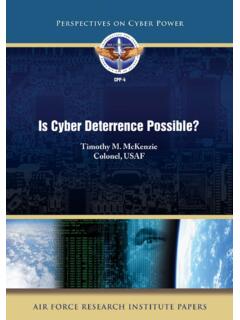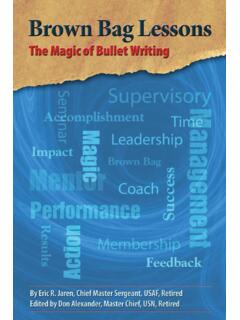Transcription of CIVIL AIR PATROL CAP REGULATION 60-1 (C1) NATIONAL ...
1 CIVIL AIR PATROL CAP REGULATION 60-1 (C1). NATIONAL HEADQUARTERS 10 JUNE 2004. MAXWELL AFB AL 36112-6332 INCLUDES CHANGE 1, 19 OCTOBER 2004. Operations CAP FLIGHT MANAGEMENT. This REGULATION prescribes the responsibilities of all CIVIL Air PATROL (CAP) personnel as applicable to the control and management of CAP flying programs, aircraft, and aircrews. Federal Aviation Administration (FAA) requirements are minimum standards, however, in some instances CAP has established higher standards than FAA minimums. The objective of this REGULATION is to encourage safety, promote effective and efficient management, establish standardization, and provide effective supervision for CAP flying activities. The practices, procedures, and standards prescribed in this REGULATION are mandatory. Suggestions for modification and improvement of the CAP flight management program should be forwarded through the chain of command to NHQ CAP/DO.
2 Note: Shaded areas identify new or revised material. SUMMARY OF CHANGES. Reflects NATIONAL Board approval for removal of Emergency Change status with changes. Para 1-5, CAP Corporate Missions, increases emphasis on corporate mission approval. Para 2-1n, General, clarifies recreational pilot restriction. Para 2-5, Geographical Limits for Flights of CAP Aircraft, updates geographical release authorization. Para 2-9, CAP Membership Cards and Uniforms, see para 5-7. Para 2-17, Prohibited Equipment, glider clothing restriction moved to chapter 5. Para 2-19c, Altitude and Lateral Distance Restrictions, has been revised. Chapter 4, Flight Release of CAP Aircraft, reflects new mission base release policy and updates flight mission symbols. Chapter 5, CAP Glider/Tow Plane/Launch Operations added. Attachment 2, CAP Aircraft Operations under FAR Exemptions, reflects new cadet orientation policy.
3 Attachment 9, Mission Pilot Proficiency Profiles, sentence added to each. Attachment 10, Flight Mission Symbols, reflects updated designations. CHAPTER 1 GENERAL 1-1. Purpose and 1-2. Responsibilities ..3. 1-3. Supplements and/or Operating 1-4. air force Assigned Mission (AFAM) USAF Reimbursable Missions ..3. 1-5. CAP Corporate Missions..3. 1-6. Explanation of Terms ..3. CHAPTER 2 GENERAL OPERATING RULES ..4. 2-1. General ..4. 2-2. Authorized 2-3. Required Airworthiness Certificate ..4. 2-4. Prohibited Uses of CAP Aircraft ..5. 2-5. Geographical Limits for Flights of CAP 2-6. Authorized 2-7. Operations Monthly Activity Report..6. 2-8. Pilot Records ..7. 2-9. CAP Membership Cards and Uniforms..7. 2-10. Aircraft 2-11. Suspension or Revocation of CAP Flying Privileges ..7. 2-12. Assessments for Damage to CAP Corporate 2-13. FAR Exemptions..8. 2-14. Corporate Aircraft Information File.
4 8. 2-15. Flight Time and Duty Limitations..9. 2-16. Crosswind Limitation ..9. 2-17. Prohibited Equipment..9. 2-18. Emergency Procedures Training 2-19. Operational Requirements and Restrictions ..9. 2-20. Over-water Operations and Reconnaissance..10. _____. Supersedes Emergency CAPR 60-1, 10 June 2004. OPR: DO. Distribution: In accordance with CAPR 5-4. 2 CAPR 60-1 (C1) 19 OCTOBER 2004. CHAPTER 3 PILOT QUALIFICATIONS AND 11. 3-1. 11. 3-2. Pilot Qualifications.. 11. 3-3. Pilot Aircraft Qualification Requirements .. 12. 3-4. Pilot-in-Command Requirements.. 13. 3-5. CAPF 5 Flight Checks.. 13. 3-6. CAP Pilot Flight Training Leading to an Additional Airman Rating or Certificate .. 14. 3-7. Standardization and Evaluation 15. 3-8. Proficiency Requirements for CAP Pilots .. 15. 3-9. Requirements for CAP Mission Check Pilots and CAP Mission 15. TABLE 3-1. AIRCRAFT 16. CHAPTER 4 FLIGHT RELEASE OF CAP AIRCRAFT.
5 17. 4-1. 17. 4-2. Flight Release on air force Assigned Mission USAF missions (AFAM-USAF) .. 17. 4-3. Flight Release on CAP Corporate Missions .. 17. 4-4. Flight Release of USAF Liaison Contract Rental Flights .. 18. 4-5. Flight Release Officer Qualifications .. 18. 4-6. Flight Release Officer Responsibilities and Procedures .. 18. 4-7. Flight Release of Multiple Flight Activities.. 18. 4-8. Glider Flight Reporting Procedures and Requirements .. 18. 4-9. Flight Release: Commanders' and Pilots' Responsibilities.. 18. CHAPTER 5 CAP GLIDER/TOW PLANE/LAUNCH 5-1. Organizational Areas of Responsibility .. 5-2. CAP Glider, Orientation, Instructor, and Check Pilots .. 5-3. CAP Tow Pilots .. 5-4. CAP Pilot Glider Flight 5-5. CAP Glider Orientation Flights .. 5-6. Flight Release of Glider Flight Activities .. 5-7. CAP Member Soaring Uniform .. 5-8. SSA Affiliate Club Launch Aircraft & Equipment Operated by CAP 5-9.
6 Commercial or SSA Affiliate Club Launch Aircraft & Equipment Operated by Other than CAP Personnel .. 5-10. Glider Check Pilot Requirements. NATIONAL Check Pilot Standardization Course Glider (NCPSC-G) .. 5-11. Flight Encampments/Academies .. 5-12. Tow Pilot Requirements .. 5-13. CAPF 5G ATTACHMENT 1 STATEMENT OF UNDERSTANDING .. 20. ATTACHMENT 2 CAP AIRCRAFT OPERATIONS UNDER FAR EXEMPTIONS .. 21. ATTACHMENT 3 AIRPLANE QUESTIONNAIRE .. 24. ATTACHMENT 4 GLIDER QUESTIONNAIRE .. 26. ATTACHMENT 5 ADMINISTRATION OF CAPF 5/5G FLIGHT 27. ATTACHMENT 6 ADMINISTRATION OF CAPF 91 MISSION FLIGHT 29. ATTACHMENT 7 SELF-CONDUCTED PROFICIENCY FLIGHT GUIDELINES .. 31. ATTACHMENT 8 FLIGHT RELEASE OFFICER CHECKLIST .. 32. ATTACHMENT 9-1 APPROVED MISSION PILOT PROFICIENCY FLIGHT PROFILE #1. VISUAL SEARCH MISSION 34. ATTACHMENT 9-2 APPROVED MISSION IMAGING PROFICIENCY FLIGHT PROFILE #2. VIDEO IMAGING MISSION 35.
7 ATTACHMENT 9-3 APPROVED MISSION IMAGING PROFICIENCY FLIGHT PROFILE #3. ELECTRONIC SEARCH MISSION PROFILE .. 36. ATTACHMENT 9-4 APPROVED MISSION PILOT PROFICIENCY FLIGHT PROFILE #4. TRANSPORTATION MISSION PROFILE .. 37. ATTACHMENT 9-5 APPROVED MISSION PILOT PROFICIENCY FLIGHT PROFILE #5. MISSION PILOT CAPF 91 PRACTICE PROFILE .. 38. ATTACHMENT 9-6 APPROVED MISSION PILOT PROFICIENCY FLIGHT PROFILE #6. MOUNTAIN SEARCH MISSION PROFILE .. 39. ATTACHMENT 10 FLIGHT MISSION 40. CAPR 60-1 (C1) 19 OCTOBER 2004 3. CHAPTER 1 GENERAL INFORMATION. 1-1. Purpose and Scope. This REGULATION prescribes NATIONAL standardization for the CAP flight management program. 1-2. Responsibilities. All commanders and members are responsible for strict enforcement and compliance with the provisions of this REGULATION as well as the management of risks associated with flight and mission accomplishment. The authorization to operate CAP aircraft is a privilege, not a right.
8 1-3. Supplements and/or Operating Instructions. No unit below wing level may issue supplements or operating instructions (OIs) to this REGULATION (except the Congressional Squadron). a. Supplements or OIs must be consistent with the intent of NATIONAL standardization of the CAP flight management program and cannot reduce the requirements of this REGULATION . b. Proposed supplements, OIs, or changes thereto, shall be submitted to NHQ CAP/DO for approval prior to issuance. If this REGULATION revision affects a currently approved supplement or OI, the affected supplement or OI shall be updated and submitted for approval within 6 months after the effective date of this REGULATION . The affected supplement or OI will be void 6 months from the effective date of this publication. c. Wings operating hot air balloons in CAP flight activities shall publish flight management and operating procedures in a supplement to this REGULATION IAW paragraph above.
9 1-4. air force Assigned Mission (AFAM) USAF Missions. The CAP, as the civilian auxiliary of the USAF, is authorized to perform certain assigned missions of the air force . These missions may either be reimbursable or nonreimbursable, depending upon the particular mission. Additionally, the CAP may be assigned by the USAF to provide services to other federal, state, local, and private agencies. The air force determines which missions the CAP will perform as USAF missions on behalf of the air force and other agencies. USAF missions in CAP aircraft include all flights to, from, and in conjunction with the assigned mission. All CAP missions assigned by the air force , whether in support of the air force or other agencies, will be issued an air force mission number or symbol. 1-5. CAP Corporate Missions. A commander who is a corporate officer may authorize a CAP flight. These commanders may delegate their authority to a limited number of other wing/region leaders.
10 Corporate officers must act very judiciously when they delegate corporate mission approval authority. Approving corporate missions carries with it a very serious responsibility to weigh the risks associated with conducting each mission. These decisions directly affect CAP's corporate insurance policy premium. Minimizing risks through prudent decision-making will ensure CAP is able to continue to perform corporate missions in the future. 1-6. Explanation of Terms. The following terms and acronyms used throughout this REGULATION are defined and explained as follows: a. CAP Aircraft. Any aircraft (either member owned/furnished or CAP corporate) used in a CAP flight activity. b. CAP Corporate Aircraft. Any aircraft owned by and registered to CAP and any aircraft under an exclusive lease to CAP. c. CAP Pilot. A CAP member holding an FAA pilot certificate who is authorized to operate CAP aircraft on CAP.



